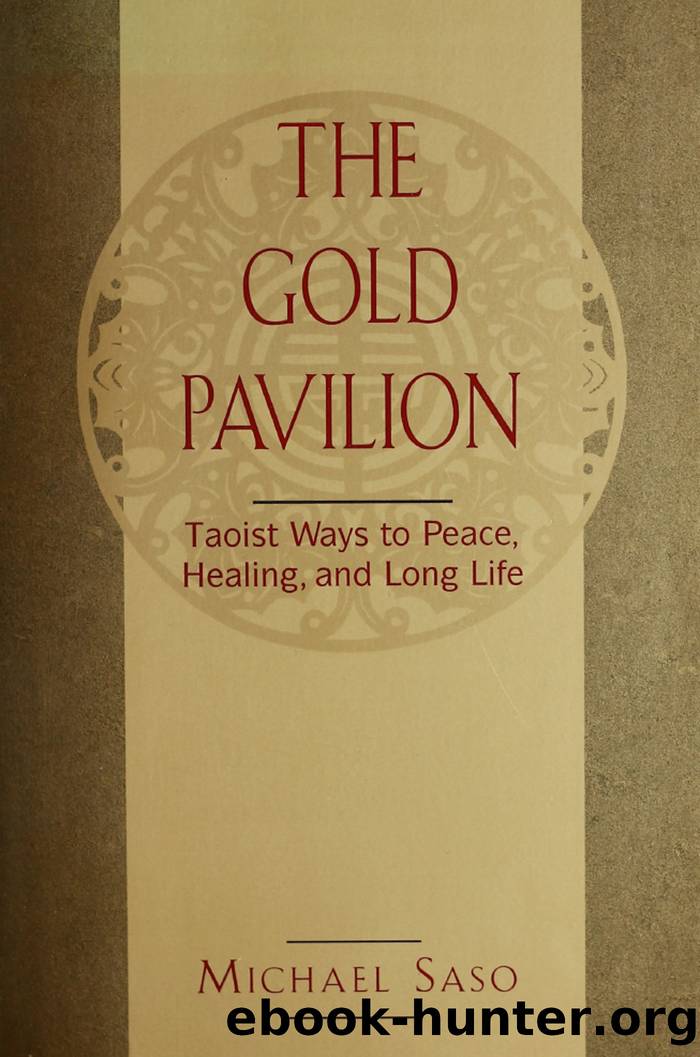The Gold Pavilion by Michael Saso

Author:Michael Saso
Language: eng
Format: epub
ISBN: 978-1-4629-0748-9
Publisher: Tuttle Publishing
Organ Direction Season Color Element Number Symbol Spirit
liver east spring green wood 3 dragon Fu Hsi
heart south summer red lire 2 phoenix Shen Nung
spleen center human gold earth 5 cauldron Huang Ti
lungs west autumn white metal 4 tiger Shao Hao
kidneys north winter purple water 1 tortoise Chuan Hsu
The term hai-yüan or ocean depths refers to the kidneys. Thus the heart and the other organs, the elements, directions, mind's thoughts, and heart's desires are all to be fa, governed or washed pure in the water of the kidneys before having audience with the Tao in the Gold Pavilion.
LINE 36 The chen-jen, literally the "true" human, is a person who "sits in forgetfulness" and "fasts in the heart." Only Tao dwells within the center of the person who is empty, according to the Chuang-tzu, chapter 4. The "lone cinnabar sphere" refers to the center of the Gold Pavilion where a bright red drop of light, Tao gestating primordial breath, appears before the meditator.
LINE 37 The term san kuan, three passes, has multiple meanings, depending on the interpretation given the passage. For the Taoist master it means the passages of ch'i breath, shen will, and ching intuition, sent inward to the Gold Pavilion or outward to the world of change. The text says that the three passages (in this case into the Gold Pavilion) are filled with ch'i breath, mind's focus, and ching intuition, belly's awareness. Mind controls the passage of ch'i from the upper cinnabar field, the pineal gland in the brain. Heart controls the passage of will-desire and the flow of words outward through the mouth and the hands to attain desires. The lower cinnabarfield,the organs of the belly and the lower body, controls the outward flow of ching (emotional and intuitive awareness) and other fluids, wastes, and dispositions of the body. Intuitive awareness preserves ching within.
Note that the sexual hygiene school takes ching in the literal sense of semen, teaching that the male should not let semen flow away during intercourse, to nourish his own body instead with the retained semen. The female in turn is taught not to reach orgasm in order to "steal" the male essences and to preserve her own bodily fluids. Both the classical Taoist schools and reformed Ch'üan-chen Taoism reject all practice of sexual hygiene as non-Taoist, a form of selfish and self-centered practice unrelated to Lao-tzu or Chuang-tzu. If taken in the meditative rather than the physical sense, the three passages are conduits of ch'i breath awareness, shen will, and ching intuitive feelings inward to the Gold Pavilion or outward to be dissipated in search of fame, name, and possessions. The three outward paths are the nose and mouth for breath, the mouth and hands for will's desires, and the lower organs of the body for sensual gratification. The three inward passages are the brain center, the pineal gland (called Mount K'un-lun in the next line); the twelve stages of the spine (between the head and the heart) through which ch'i energy circulates; and the heart (pericardial area) itself.
Download
This site does not store any files on its server. We only index and link to content provided by other sites. Please contact the content providers to delete copyright contents if any and email us, we'll remove relevant links or contents immediately.
The remains of the day by Kazuo Ishiguro(8828)
Tools of Titans by Timothy Ferriss(8224)
Giovanni's Room by James Baldwin(7199)
The Black Swan by Nassim Nicholas Taleb(7016)
Inner Engineering: A Yogi's Guide to Joy by Sadhguru(6728)
The Way of Zen by Alan W. Watts(6509)
Asking the Right Questions: A Guide to Critical Thinking by M. Neil Browne & Stuart M. Keeley(5651)
The Power of Now: A Guide to Spiritual Enlightenment by Eckhart Tolle(5610)
The Six Wives Of Henry VIII (WOMEN IN HISTORY) by Fraser Antonia(5398)
Astrophysics for People in a Hurry by Neil DeGrasse Tyson(5134)
Housekeeping by Marilynne Robinson(4349)
12 Rules for Life by Jordan B. Peterson(4250)
Double Down (Diary of a Wimpy Kid Book 11) by Jeff Kinney(4208)
The Ethical Slut by Janet W. Hardy(4178)
Skin in the Game by Nassim Nicholas Taleb(4165)
Ikigai by Héctor García & Francesc Miralles(4125)
The Art of Happiness by The Dalai Lama(4063)
Skin in the Game: Hidden Asymmetries in Daily Life by Nassim Nicholas Taleb(3935)
Walking by Henry David Thoreau(3897)
